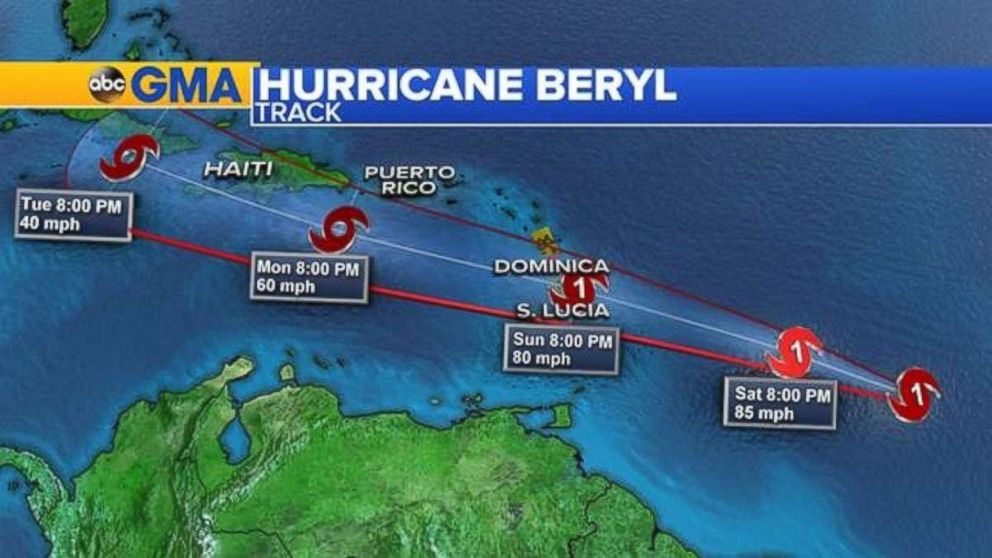Hurricane Beryl’s Impact on Jamaica: Hurricane Beryl Jamaica

Hurricane beryl jamaica – Hurricane Beryl, a Category 1 hurricane, made landfall in Jamaica on July 12, 2018. The storm brought heavy rains and winds, causing significant damage to the island’s infrastructure, economy, and environment.
Hurricane Beryl made landfall in Jamaica on July 12th, bringing heavy rains and strong winds. The storm caused significant damage to the island, leaving many without power and water. The storm is now moving towards the Gulf of Mexico, and is expected to strengthen into a hurricane again.
For the latest hurricane beryl forecast , please visit the National Hurricane Center website.
Impact on Infrastructure
The hurricane’s strong winds and heavy rains caused widespread damage to buildings, roads, and utilities. Many homes were destroyed or damaged, and businesses were forced to close. The storm also knocked out power and water service to large parts of the island.
Hurricane Beryl, a tropical storm that drenched Jamaica with heavy rains and gusty winds, has weakened to a tropical depression as it moves towards the Dominican Republic. Hurricane Beryl Dominican Republic is expected to bring heavy rainfall and possible flooding to the island nation.
The storm is forecast to continue weakening as it moves over Hispaniola, but it could still cause significant damage in both Jamaica and the Dominican Republic.
Impact on Economy
The hurricane’s impact on Jamaica’s economy was significant. The storm caused damage to agriculture, tourism, and other sectors. The banana industry, one of Jamaica’s main exports, was particularly hard hit. The storm also caused damage to hotels and other tourist infrastructure.
Jamaica’s Response to Hurricane Beryl
The Jamaican government responded swiftly to Hurricane Beryl, implementing a comprehensive plan to safeguard citizens and mitigate the storm’s impact. Evacuations were ordered in vulnerable coastal areas, and emergency shelters were established to provide refuge for those displaced. The government also deployed disaster relief teams to affected areas, distributing essential supplies, providing medical assistance, and coordinating cleanup efforts.
International Aid and Assistance, Hurricane beryl jamaica
International aid organizations played a crucial role in supporting Jamaica’s recovery efforts after Hurricane Beryl. The United Nations, the Red Cross, and other humanitarian groups provided emergency funding, relief supplies, and technical assistance. These organizations worked closely with local authorities to ensure that aid reached those in need and that recovery efforts were coordinated effectively.
Lessons Learned and Preparedness
Hurricane Beryl served as a valuable lesson for Jamaica, highlighting the importance of disaster preparedness. The government has since reviewed its emergency response plans and implemented measures to enhance its ability to respond to future hurricanes. These include strengthening early warning systems, improving evacuation procedures, and investing in disaster-resistant infrastructure. By learning from the experiences of Hurricane Beryl, Jamaica is better equipped to mitigate the impact of future storms and protect its citizens from harm.
Hurricane Beryl’s Impact on Jamaica’s Environment

Hurricane Beryl brought strong winds and heavy rainfall to Jamaica, causing widespread damage to the island’s natural environment. The hurricane’s impact was particularly severe on Jamaica’s coastal ecosystems, including coral reefs and mangroves.
Impact on Coastal Ecosystems
Hurricane Beryl’s strong winds and waves caused significant damage to Jamaica’s coral reefs. The reefs are home to a diverse array of marine life, including fish, mollusks, and crustaceans. The hurricane’s impact on the reefs is likely to have a ripple effect on the entire marine ecosystem.
In addition to the damage to coral reefs, Hurricane Beryl also caused damage to Jamaica’s mangroves. Mangroves are salt-tolerant trees that grow in coastal areas. They provide a number of important ecosystem services, including protecting the coastline from erosion, filtering water, and providing habitat for fish and other wildlife.
Impact on Terrestrial Ecosystems
Hurricane Beryl’s strong winds also caused damage to Jamaica’s terrestrial ecosystems, including forests and agriculture. The hurricane’s winds uprooted trees and damaged crops. The damage to forests is likely to have a long-term impact on Jamaica’s environment, as it will take years for the trees to regrow.
Efforts to Restore and Protect Jamaica’s Environment
In the aftermath of Hurricane Beryl, the Jamaican government and environmental organizations are working to restore and protect the island’s environment. These efforts include planting trees, restoring coral reefs, and protecting mangroves.
The restoration of Jamaica’s environment is a long-term process, but it is essential for the island’s future. The island’s natural environment provides a number of important benefits, including food, water, and protection from storms.